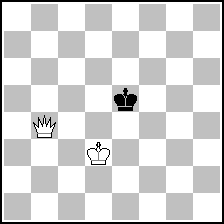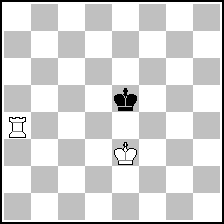
Website founded by
Milan Velimirović
in 2006
22:56 UTC


| |
MatPlus.Net  Forum Forum  General General  Mating in Dice Chess Mating in Dice Chess |
| |
|
|
|
|
You can only view this page!
| | | (1) Posted by Hauke Reddmann [Friday, Dec 20, 2013 12:29] | Mating in Dice Chess
Yesterday I played a silly OTB variant (throw a die, move
figure that die indicates).
A question came up: can you mate with KQ-K in Dice Chess?
Note that in the position Kb6 Qd7 - Kb8 it can happen that
your die (or rather coin, to avoid rethrowing - standard
rule is "repeat", but you can also play "free" or "switch")
shows "K" arbitrarily long, but this is arbitrarily
improbable, and the average length to mate is the limes of
1/2(Q)+2/4(KQ)+3/8(KKQ)+4/16(KKKQ)+... which converges to 2,
so this position is statistically a #2. :-)
I'm fairly sure KQ/K poses no mating problems, but can anyone
give a surefire algorithm? What about KR/K, offhand I found no clean
way to a deterministic mate?
Hauke
| | | (2) Posted by Geir Sune Tallaksen Østmoe [Friday, Dec 20, 2013 23:57] |
I think the following algorithm works, assuming that you will never get stuck rolling only Q or only K for eternity:
First, move wQ to the 4th rank (or an equivalent) with bK on the 5th. That is always possible without the aid of wK. Then move wK to d3/e3, while keeping wQ somewhere between b4-g4. Now the position will be something like this:
 (= 2+1 ) (= 2+1 )
From here, each time you roll a Q, use every opportunity to gain a rank. In order to avoid that as long as possible, bK must stay on the 5th rank, so I will always assume that is what he does.
If you roll a K in the diagram position, move between d3/e3. If you roll a Q, play Qd4. bK goes to f5. Move wK to e3/f3 and play Qe4. bK goes to g5. Move wK to f3/g3 and play Qf4, etc. This way, bK must eventually go to the 6th rank and allow wQ to go to the 5th rank. Repeat the process until bK is on the 8th rank, after which you threaten mate on every move and execute it when you roll a Q.
You may be in the situation that you roll too many Qs in a row for this algorithm, but then you can just move one step back. For example, in the diagram, play may continue 1.Qd4+ Kf5 2.Qe4+ Kg5, and then you roll a Q again. Then simply play 3.Qd4, moving back and forth until you roll a K and get to play Ke3.
K+R vs K is another story. I cannot find a safe algorithm here. In order to win that, I think you just have to cut the king off, rank by rank, and assume that at some point, you will get the right sequence of rolls to force bK backwards.
| | | (3) Posted by Hauke Reddmann [Saturday, Dec 21, 2013 16:13] |
KR/K: It would suffice that you could prove with any "wrong" sequence
you can make a "pass" manouvre. The right one will come eventually,
with probability 1.
The opposition method obviously can't work, White hangs his R with
nonzero probability. You can still try the "squaring-in" approach,
but you have to avoid that Black walks around the K.
Hauke
| | | (4) Posted by Geir Sune Tallaksen Østmoe [Saturday, Dec 21, 2013 20:30] |
In that case, I think the opposition method works, although you will probably have to wait for a long time for the right sequence to appear. White must move the rook to an unguarded square, but as long as he can defend it with a series of king moves, it doesn't matter. Consider this position:
 (= 2+1 ) (= 2+1 )
If White rolls R, he plays 1.Ra5+ and gains a rank. After 1...Kd6, White defends his rook with Kd4-c4-b4 if necessary, and once he rolls a R, he can move it to h5 if bK is on the queenside, so the rook will never be lost.
If White rolls K, he plays 1.Kd3 , keeping close enough to the rook, while waiting for his next chance to check bK backwards.
| | | (5) Posted by Hauke Reddmann [Sunday, Dec 22, 2013 14:34] |
The most annoying thing that can happen in this position
would be (coin shows the piece moving, of course):
Kd3 Kf5
Tb4 Ke5
Kc3 Kd5
Kb3 Kc5
Tc4+ Kd5
i.e. White losing the opposition.
I think it's sensible to do this: Start with the bK already on the
lowest rank, R on the second and wK on the third. Consider
of these positions only those that are "safe" for the wR.
Show all these positions are "connected" by White moves.
Since some of them allow #1, a random walk will come up with this
with finite expectation value. Since adding another rank
after the #1 leads to a "safe" position, we're done.
I will eventually write a program - when Xmas, Xmas Chess Cup
and New Year are survived :-)
Hauke
| | | (6) Posted by Georgy Evseev [Sunday, Dec 22, 2013 16:32] |
Well, it looks like white are able to mate from position Kg2 Rf1 - Kg4.
White want to give check Rf4 when black king is on h4. If white have to do something else they oscillate rook between f1-f2 or king between g2-h2.
If after the check white roll rook again, it goes back to f1 and white wait for next opprotunity. If they roll a king then it moves to third line taking the opposition against black king. (White do not want to have position like Kg3 Rf4 - Kg5 with white to move and roll a king).
Then they continue the same tactics on next ranks, finishing in the end with Rf8#.
| | | (7) Posted by Steven Dowd [Monday, Dec 23, 2013 01:01] |
We used to play "Walter Browne's Las Vegas Chess" which I assume is similar.
But we didn't play it for long for precisely reasons like this. Trivial wins became not so trivial. It wasn't that hard to win, but it took forever, and slowing down the pace at the club was not what we were into in those days.
| | | (8) Posted by Arno Tungler [Tuesday, Dec 24, 2013 03:38] |
We played it with the rule that you can use any unit if you have no chessman on board with the diced number. That avoids those lengthy endplays but also changes the strategy (it is desirable to lose all officers of one kind)...
| |
No more posts |
MatPlus.Net  Forum Forum  General General  Mating in Dice Chess Mating in Dice Chess |
|
|
|
 ISC 2024
ISC 2024 Forum
Forum  General
General  Mating in Dice Chess
Mating in Dice Chess 


